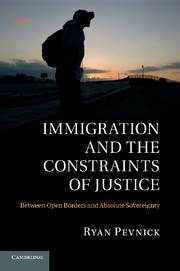Book contents
- Frontmatter
- Contents
- List of illustrations
- Acknowledgments
- 1 Introduction
- 2 Statism, self-determination, and associative ownership
- 3 Refining associative ownership
- 4 Rights-based arguments for open borders
- 5 Distributive justice and open borders
- 6 The significance of national identity
- 7 Applications
- Bibliography
- Index
5 - Distributive justice and open borders
Published online by Cambridge University Press: 24 February 2011
- Frontmatter
- Contents
- List of illustrations
- Acknowledgments
- 1 Introduction
- 2 Statism, self-determination, and associative ownership
- 3 Refining associative ownership
- 4 Rights-based arguments for open borders
- 5 Distributive justice and open borders
- 6 The significance of national identity
- 7 Applications
- Bibliography
- Index
Summary
In the previous chapter, I argued that there is no general moral right to free movement and that, as a result, it is a mistake to suggest that the case for open borders can be established simply by reference to rights of free movement. Nevertheless, two strategies for arguing for open borders remain: those based on overall productivity and those based on distributive justice. In this chapter, I assess these remaining strategies, arguing that neither line of argument is capable of justifying open borders.
EFFICIENCY, DISTRIBUTIVE JUSTICE, AND OPEN BORDERS
Sometimes, more often among economists than political theorists, the case for open borders hinges on claims regarding the potential for enormous gains in productivity. Although not themselves advocating open borders, Caglar Ozden and Maurice Schiff explain that “by allowing workers to move to areas where they are more productive and valued, migration leads to a direct increase in global output and income” (Ozden and Schiff 2006, 6). On this view, open borders ought to be adopted because of the potential gains in efficiency.
Such calculations have been made by a number of economists (Hamilton and Whalley 1984; Martin 2004), and are typically based on simple estimates derived in the following way:
Imagine that per capita income is $2,000 in country X and $22,000 in country Y. Now, imagine that we increase the flow of workers from X to Y by 100,000. If the main differences in income between X and Y arise from differences in capital between the two economies (rather than differences in the skill sets of the individuals), then we can calculate the net economic benefits for the increased migration by multiplying the difference in wages by the number of individuals who will benefit from exposure to the capital-rich economy. […]
- Type
- Chapter
- Information
- Immigration and the Constraints of JusticeBetween Open Borders and Absolute Sovereignty, pp. 104 - 132Publisher: Cambridge University PressPrint publication year: 2011

